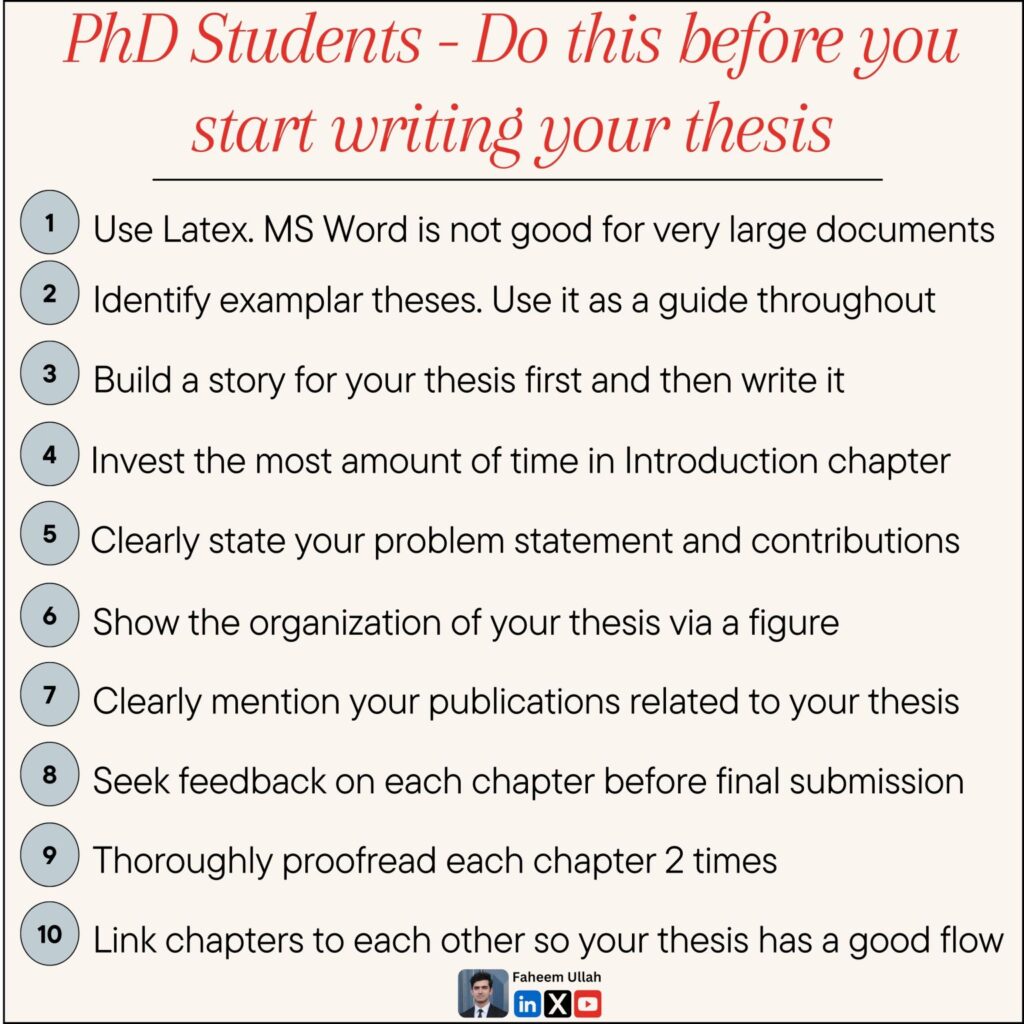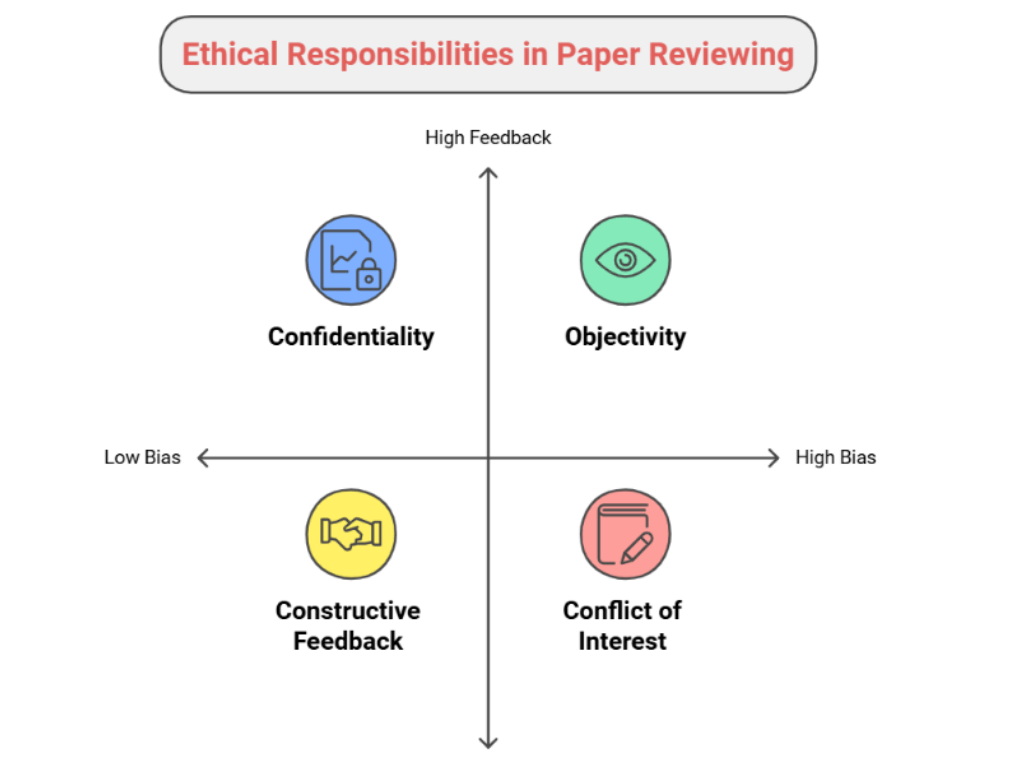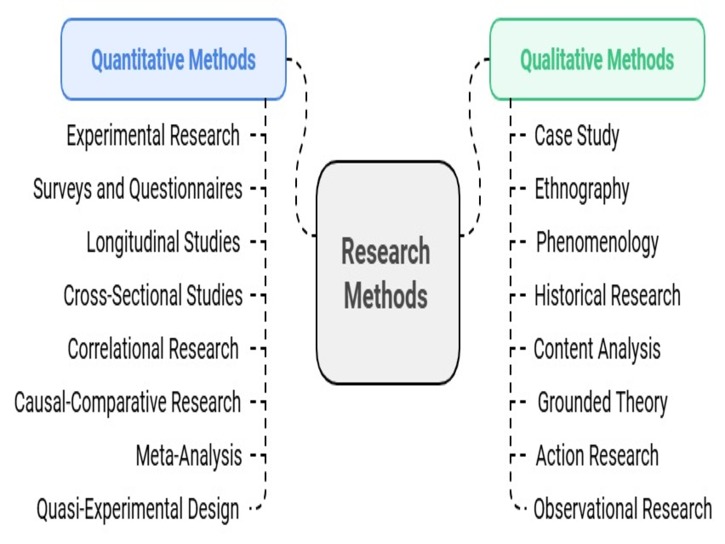Thesis writing is a nightmare in the life of every PhD student but it shouldn’t be. I know the stakes are incredibly high because you need to deliver a polished piece of work that is often the final hurdle in your academic journey. Without a clear strategy, you lose yourself in the never-ending cycle of notes and drafts.
You have already spent years on your research, you can’t waste any more time.
Can you?
I understand that because once I stood where you are now. To take all the stress of thesis writing away from you and make the whole process hassle-free, I am going to present the 10 most effective tips in this newsletter.

1.Use Latex, not MS Word
Writing a 100+ page document in MS Word can become a headache. Arranging headings, tables of content, references, etc can become a challenge. So, instead of MS Word, use LaTex. It will take care of all such things.
I admit using LaTex is quite tricky for most of us.. But once you spend 30 minutes learning LaTex, the rest of your work becomes effortless. This 30-minute investment will save you hundreds of minutes that you would otherwise spend navigating hundreds of pages on MS Word.
Regarding scientific and academic writing, Latex excels in MS Word by letting you create professional-looking documents. LaTex offers full control over document formatting so users can craft consistent-looking documents. It also makes handling large documents easy by allowing you to fully organize complex layouts, figures, and tables within your Thesis.
2. Identify Exemplar Thesis
Before starting your Thesis, identify 10-15 exemplar theses within your research area or the PhD is carried out similarly to yours. The reason for probing into these exemplary theses is to set some guidelines you will follow for your own Thesis. Skim through them, especially the first chapter, to understand how to structure your Thesis
Example: Our findings indicate that AI-powered writing assistants improve research productivity by 25%, particularly in the literature review and manuscript writing phases.
Here is how you will skim through different chapters of exemplar thesis:
- The introduction section helps you understand how the author introduces the research problems and sets the groundwork for subsequent chapters. Pay close attention to the thesis’s architectural structure.
- The literature review section requires a deep look at your side. Try to understand how authors use existing knowledge to determine research gaps. Do you know all about different types of research gaps?
- The methodology section clearly outlines data analysis technology and data collection methods. It also shows how the author analyzes the research design. This example analysis makes it easy for you to define your own personal approach to your research methodology.
Digging into an exemplar Thesis is crucial to understanding:
- Structure of your Thesis
- Effective research design and mythology
- Ways to improve the quality of your Thesis
- How do you present your findings most successfully?
3. Build a Story
During your PhD, you work on papers that might not be linked straightforwardly. Put these different pieces before yourself and think about how to link them and create a smooth story.
Here is how you can build a story:
1. List the main topics by reviewing each paper to identify similar methodologies or problems. You can easily link together common recurring themes throughout your research.
2. You can create a concept map based on your thesis’s shared themes, findings, or methodologies. This visual map helps you identify potential areas you can link to present a smooth story to your examiner.
3. Once you have identified commonalities, the next step is to develop a central thesis, highlighting the core insight or contribution of your collective research.
4. Adjust each paper’s introduction or conclusion to emphasize how each paper contributes to the broader Thesis.
5. Bridge the research gap between your diverse papers by integrating literature reviews that ultimately support all the connections you are building.
6. Add a narrative link within your Thesis. Explain how one chapter is connected to another so that your dissertation demonstrates cohesiveness and consistency.
PRO TIP- Whenever you are building a story, remember to share it with your advisors or peers. Two minds are always better than one, so getting feedback helps you improve weak links and build a powerful story.
Struggling to Identify Research Gaps
SciSummary makes it effortless by analyzing multiple research papers and pinpointing key gaps in your field.
What can you do with SciSummary?
➟ Upload up to 10 relevant research papers
➟ Get AI-generated combined and individual summaries
➟ Identify research gaps by asking targeted questions
➟ Quickly refine and explore key insights
Exclusive Offer: Use discount code FAHEEM25 for 25% off!
Check it out here: www.scisummary.com
4.Introduction Can Make or Break the Deal:
The Introduction chapter summarizes your whole Thesis and leaves an impression on the reader/examiner. Invest the most time in writing this chapter. Amongst others, mention the research papers you published during your PhD.
Here are must-have things to add to the introduction so that this chapter engages your examination from the very start:
- Remember to add a compelling hook, a question or an unusual fact related to your main research theme.
- Provide background information in a way that readers feel the need to research problems naturally.
- Your statement of the problem should be clear. Readers must feel that investigating the problem is worth their time.
- A list of research questions and objectives is an absolute must.
- Explain the potential impact and value of your research (The reader must feel the need to look into this matter).
- Introduce your research methodology briefly; don’t explain too much.
- Last but not least, don’t forget to mention all the work you published during PhD related to the Thesis; again, it’s to build interest and impact of your Thesis over the examiner.
5. Crisp Problem Statement and Contributions
Mention within 3-4 lines the concrete problem you have solved during your PhD. Examiners also look for 3-4 solid contributions. Could you not make them search for them? Present these contributions upfront in the Introduction chapter. When presenting a PhD thesis, you must demonstrate the value of your research.
You can do that by presenting key findings in the introduction and highlighting your contributions. Instead of burying your contributions (hard work) within the body of your Thesis, always add them in the introduction section so that it becomes easy for an examiner to assess the importance of all the work you have done and all the problems you have solved during your research.
6. Thesis Organization via a Figure
PhD thesis is a very long document. Navigating through it can be a challenge. Include a figure in the Introduction section that shows the organization of the Thesis, including the various chapters. You can check my PhD thesis for such a figure.
Here are five ideas that you can use to organize your Thesis through a figure:
- Create a Hierarchical Structure: A tree diagram is the most suitable figure to organize your Thesis, especially when each chapter has several sub-chapters.
- Go with Circular Format: You can make the most of circular figures when you have interconnected chapters. IT will demonstrate how one chapter supports another chapter to the examiner.
- Try a Numbered List with Brief Chapter Descriptions: It is a simple way to let the examiner digest everything about your research.
- Present Chapters Along a Timeline: It will help the examiner look into the complete journey of your PhD.
- Use Software Tools—Make the most of graphic design tools such as PowerPoint, Microsoft Visio, or Lucid Chart. The best thing about software tools is that they unlock various templates to create the most suitable figure according to your thesis structure.
7. Clearly Mention your Publications
If you have published some of your research, mention it upfront in your Thesis. This shows to reviewers that part of your research has already been peer-reviewed. You can guide the examiner’s expectation by mentioning publication in the introduction so that the examiner will fully understand the depth and quality of your work. An early mention of publication helps you highlight the impact of your research and establish credibility. Examiners will know that your job already adds valuable insight into your field.
Here is how to mention your publication effectively in your thesis:
Early mention– It means mentioning publication in the introduction section
Add visuals- Create a table or diagram that demonstrates all your contributions and published work
Emphasize relevancy- Don’t just list all publications; explain briefly how they are relevant to your Thesis.
Build a cohesive narrative-You often mention publication in the introduction and then forget about it. Don’t do that. Integrate it throughout your Thesis when explaining related methods, questions, and findings.
8. Seek Feedback
Manage your writing so that each part gets reviewed. If you are running short of time, you can send each chapter separately as it is completed to your supervisors for feedback.
Here is how you can get complete feedback on every chapter of your thesis in a short time:
- Break the thesis into manageable chapters and set a realistic timeline for creating a chapter, getting feedback, and making changes to each chapter.
- Schedule regular meetings with your supervisor once or twice a week. These meetings could be in-person or virtual.
- Once you get feedback, work on the comments and proactively make changes in upcoming chapters to save time and effort.
- Rely on real-time collaboration tools for review, such as MS Word’s Review and Google Docs. I personally prefer Google Docs, as it makes real-time collaboration effortless.
Don’t forget to read: 10 Simple Ways to 10x your PhD Productivity
9. Thoroughly Proofread
One of the most common comments from thesis reviewers is to fix the typos. Proofread your entire Thesis several times before submission to avoid getting this comment.
Here is how to thoroughly proofread your Thesis:
- Plan multiple readings; please don’t rely on a single reading, as it will be tiresome and useless.
- Take breaks between proofreading sessions.
- Hire a professional proofreader; every penny is worth it only when you hire a reliable one.
- Make the most of some proofreading tools, such as Spell Check and Grammarly or AI Proofreading tools like Quilbot—they will save you a lot of time.
- Proofreading doesn’t mean looking into spelling, Grammarly, or punctuation mistakes. You need to go beyond typos and proofread format as well. This means you will look into font size, citation style, margins, spacing, and heading styles to ensure consistent formatting.
- Involve peers and friends to get the proofreading support that everyone needs.
10. Link Chapters to Each Other
Make sure the chapters are linked. For example, it shouldn’t appear that when the reviewer starts reading Chapter 4, it is completely different from Chapter 3.You can interlink all the chapters within your Thesis by starting a new chapter by referring to key takeaways from the previous chapter and then explaining the new chapter’s purpose and structure.

Find me on Instagram


